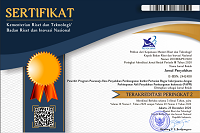Dukungan Lingkungan Sosial Budaya terhadap Kemampuan Petani dalam Pengelolaan Hutan Kemiri di Kabupaten Maros Provinsi Sulawesi Selatan
Abstract
living around the candlenut forest in Maros District have been managing and utilizing candlenut forest since 1826. These activities have been part of their daily living activities. The existence of candlenut forest is a successful evidence of farmers ability in managing that forest. It is presumed that the cultural social environtment has important roles to form the farmers’ ability to manage and to utilize candlenut forest. The research intended to analyze the contribution of cultural social environment to farmers’ ability in managing and utilizing candlenut forest. The data were collected on January-Maret 2010 in Maros District, South Sulawesi Province using some methods: questionnare list, interview, observation, and documents. The data were analyzed using (1) descriptive statistics, and (2) inferensial statistics based on SEM using LISREL 8.70 software programming. The result shows that farmers’ contribution of cultural social environment, today is low. It, however, has a positive contribution for increasing farmers’ ablity.
Key words: Cultural social environment, farmers ability, community candlenut forest
Downloads
Authors who publish with this journal agree to the following terms:
- Authors retain copyright and grant the journal right of first publication with the work simultaneously licensed under a

This work is licensed under a Creative Commons Attribution 4.0 International License that allows others to share the work with an acknowledgement of the work's authorship and initial publication in this journal. - Authors are able to enter into separate, additional contractual arrangements for the non-exclusive distribution of the journal's published version of the work (e.g., post it to an institutional repository or publish it in a book), with an acknowledgement of its initial publication in this journal.
- Authors are permitted and encouraged to post their work online (e.g., in institutional repositories or on their website) prior to and during the submission process, as it can lead to productive exchanges, as well as earlier and greater citation of published work (See The Effect of Open Access).















